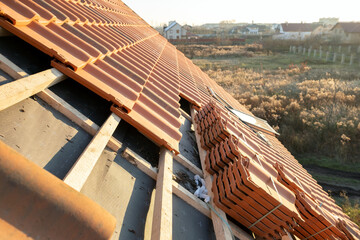Whether you’re building a new home or reroofing an existing one, the materials you choose for your roof will have a significant impact on construction and energy costs. They also affect resale value and maintenance costs.
The most visible part of a home’s structure is its roof. It protects a house from sunlight, rain, snow, and extreme temperatures. Visit https://www.springvalleyroofing.com/ to learn more.

There is a wide selection of roofing materials that protect the tops of homes and buildings. Many are expressly designed to complement the architectural style, while others serve critical functions such as insulating, fireproofing, and energy efficiency. These materials can be found in an array of shapes, sizes, and colors to suit the needs of any climate and architectural style.
The most common and popular residential roofing material is shingles. These are available in an assortment of color and texture variations and can be made from a variety of base ingredients such as wood, tar, coal tar and asphalt. There are also shingles that are designed to mimic the look of other roofing materials such as cedar shakes or slate.
Slate is a natural roofing material that is very durable and can last for up to 200 years. This is one of the most expensive roofing materials, but it is also extremely fireproof and resistant to high winds and extreme temperatures.
Clay tiles are a popular roofing material that is often used in warm climates because it is fire-resistant and energy efficient. This material can be quite heavy though, which requires additional support structures and can increase installation costs.
Concrete is another roofing material that is gaining popularity. It is a bit more expensive than clay tile, but it is also very durable and can last for up to 50 years.
There are even roofing materials that are designed to provide superior insulating capabilities, especially in cold climates. These include reflective shingles that can help to keep the house cooler in the summer and warmer in the winter, as well as solar shingles that can generate electricity.
The roof is one of the most important parts of any structure, and it serves a vital role in protecting a building from rain, snow, sunlight and extreme temperatures. Throughout history, roofs have been constructed of a wide variety of materials for a multitude of reasons, from economic and aesthetic considerations to practical issues like durability and weather resistance.
Regardless of what kind of roof you have, it is important to maintain it properly in order to avoid any major problems. If you are having difficulty with your roof, it may be time to hire a professional roofing contractor.
Homeowners often overlook the significance of roof color when choosing shingles, but the choice can have big effects on resale value. Many homeowners choose to select colors that match the siding and trim of their homes. This helps the home blend in with the neighborhood and gives the overall impression of a cohesive whole.
It’s also important to consider the design of your neighborhood and the aesthetic of your local area when choosing a roofing material and color. Some neighborhoods and community housing associations have strict CC&Rs about the types of materials (and colors) that can be used on homes in the neighborhood. While painting your roof gold may fit your aesthetic, it might not go over well with neighbors who want to sell their homes down the road.
Other considerations include the climate where you live, the style of your home, and your personal preferences. For example, lighter colored shingles help reflect UV rays, which can keep the house cooler in summer months. And in some mountainous areas, earthy colors like greens or browns blend into the surroundings better than dark shingles.
Roofing is the process of installing the protective covering over the top of a building. It involves selecting materials that are durable, functional, and aesthetically pleasing. It also involves constructing and repairing the roof to protect against snow, rain, sunlight, and other environmental elements. Roofing is difficult work that requires a strong back, good balance, and the ability to climb a ladder. It is best left to professionals who are not afraid of heights.
The contractor will begin with the first row of shingles and nail them in a pattern that is close along the edge and spreads out towards the middle.
It’s important to make time on a regular basis to check your roof for damage and debris. This is especially important after heavy storms or each season. Look for shingles that are loose or missing, make sure gutters are clear of debris and that the flashing around skylights, vents, chimneys and dormers is in good condition. Adding caulking to these areas can help prevent leaks and other problems. Trimming any tree branches that hang over your roof can also help to protect it from damage during a storm. Lastly, cleaning the soffit and fascia can help to prevent moisture problems in the attic. This is an area often overlooked by homeowners.
A roof may look simple from the outside, but it has many internal and external structures that serve its purposes. Learn the terms and definitions for each part of a roof to understand how it works.
A shingle is a small piece of building material used to cover a roof. Shingles are available in a wide variety of colors, shapes and profiles.
Homeowners have a multitude of options when it comes to roofing materials. Asphalt shingles, wood shingles or shakes, clay or concrete tiles, slate and metal roofs are among the popular choices. Each type of material is suitable for different climates and styles of construction. It’s important to consult with a professional when selecting a roofing material to ensure it’s appropriate for your home.
Choosing the right roof can help you protect your home for years to come. There are a few things to consider when making this decision, such as lifespan, durability and cost. In addition, it’s important to understand the maintenance requirements of each type of roof.
A wood roof comprises shingles or shakes, and is often crafted from cedar, redwood, pine or cypress. Shingles are milled to a uniform size and thickness, while shakes are hand split into wedges. While these types of roofs are durable, they require regular maintenance to avoid rot and mold. They are also more expensive than other roofing materials.
Slate is a durable option that can last up to 150 years, and it’s highly resistant to temperature changes, fire, wind and hail. Known for their elegance and durability, slate roofs are commonly found on luxury homes.
Concrete tiles can be designed to resemble other types of roofing materials, including clay. They’re durable and provide excellent insulation, helping homeowners save on energy costs. However, they can be prone to cracking and are heavy, requiring additional structural support.
Clay tiles are durable and aesthetically pleasing, and they’re available in a variety of colors and profiles. They can be left unglazed, displaying their natural earthen clay color, or they can be glazed for added protection and style.
Rolled roofing is a lightweight and affordable option that can be used on low-sloped roofs. It’s typically made from one layer of organic or fiberglass felts coated with bitumen, coal tar pitch or another hot asphalt product. The layers are laminated together and covered with a mineral granule surface or a reflective coating to protect the roof from UV light degradation.
When a contractor installs roofing, they will start with a sheet of underlayment. They will overlap the first row by six inches and nail it down close to the edge with cap nails. The next row will be nailed down with the nails spread out further away from the edge. This pattern will continue through several rows until the contractor reaches the roof’s ridge. They will then run the underlayment over the ridge. The contractor will also flash any metal at the chimney, vents, valleys and around eaves. They will almost always trash the old flashing. Often it is made of galvanized steel, which is not safe to use for roofing.
Keeping the roof of your home in good condition prevents more expensive damage to rafters, walls and other components of the building structure. It also protects your family by acting as a barrier between the elements and inside of the house. Routine maintenance tasks include trimming tree limbs that hang over the roof, inspecting chimneys for cracks and missing mortar, and regularly removing snow from the roof to avoid ice damming.
During stormy weather, tree limbs can fall onto the roof and cause serious damage. If you are not comfortable climbing up a ladder to trim tree branches, you should hire a professional to do this for you. Even when there is no storm, branches that hang over the roof can scrape shingles and cause damage. You should also check the caulking around vent pipes and chimneys on a regular basis to ensure it is in good shape.
Regularly removing snow from the roof prevents ice damming and water infiltration. If you live in an area that receives heavy snowfall, it is a good idea to use a roof rake to drag the snow instead of using a shovel because it can be more difficult to reach the ground with the latter.
If you have an attic, it is a good idea to periodically walk up there and look for soft spots on the ceiling caused by roof leaks. You can often find these spots by observing light shining through the attic and the ceiling below it. It is best to do this during a sunny day so you can see the areas that need attention.







 Cost
Cost